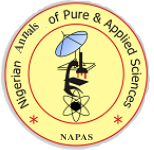Salmonella Enteric Fevers and Microbial Contamination in Public Eating Places in Makurdi, Nigeria.
DOI:
Abstract
Food, drinking water, table and utensil swab and hand washing water samples were examined for Salmonella sp contamination. Microbiological examination of samples using lactose broth, Cystine- Lactose-Electrolyte-Deficient (CLED) agar and Eosin-Methylene-Blue (EMB) agar was done to identify Salmonella sp, other organisms and indicator organisms. Indicator organisms identified were Aerobocter aerogenes and Escherichia coli. Other organisms include Streptococcus faecalis, Proteus sp and Staphylococcus aureus. 74.7% of examined samples showed Salmonella sp contamination while 89.8% of examined samples were contaminated with indicator organisms. Observed Salmonella sp were also examined biochemically to identify different species/strains. Species/strains identified were Salmonella typhi, S. paratyphi A, S. paratyphi B, S. cholerae-suis, S. enteritidis. There was a significant association between sanitary conditions and the occurrence of S. typhi in food, water, surroundings. It is very likely that poor hygiene and sanitary conditions encourage the occurrence of S. typhi in water, food, surroundings. Personal and environmental hygiene should be strictly adhered to especially in the study area so as to prevent and control S. typhi infections.



 Contact Us
Contact Us Editorial Team
Editorial Team Join As A Reviewer
Join As A Reviewer  Request For Print Copy
Request For Print Copy


 Cprint Publishers
Cprint Publishers